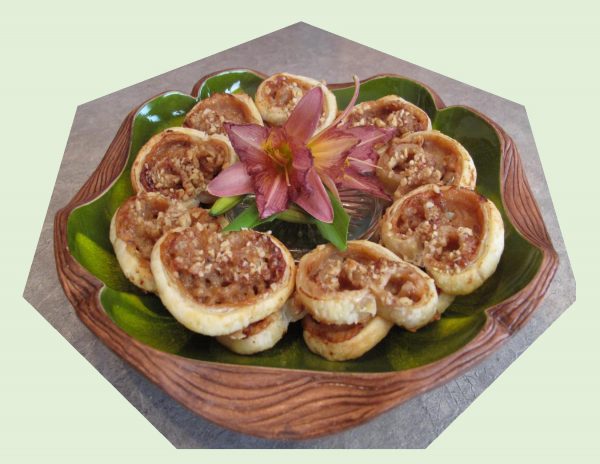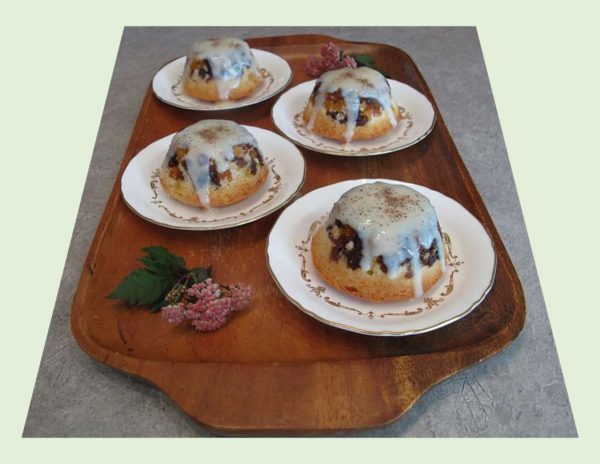
Years ago, a friend gave me a little jar of quince jam. We enjoyed the flavor but I never really gave it much thought. Recently, I came across quince paste in the grocery store. It looks quite similar to the guava paste I used in numerous recipes previously.
Of course, now its got my interest peaked to find out more about this fruit. It seems it’s a fall fruit that grows in a manner like apples and pears…… but the similarities end there. Quince are completely inedible when raw. Once cooked, they become soft and tender, usually with a nice syrup from the cooking process.
Quince fruit is native to Southwest Asia, Turkey and Iran. Historically, they were used to make marmalade. Quince cheese (also known as quince paste) is a sweet, thick jelly made from the pulp of the quince fruit. It is a common confection in several countries. Because this fruit is very high in pectin, it gels easily. Quince is sweetened with sugar and can be flavored with lemon juice, cinnamon and apple.
Quince paste is sold in squares or blocks, then cut into slices and spread over toasted bread or sandwiches, plain or with cheese. It is often used in filling for pastries or to glaze roasted meats.
I’m going to try it first in these pastries today and then maybe in a meat glaze another day.
Print Recipe
Quince, Walnut & Cheese Palmiers
Votes: 2
Rating: 4.5
You:
Rate this recipe!
|
|
Votes: 2
Rating: 4.5
You:
Rate this recipe!
|
Instructions
Open puff pastry sheet on parchment paper & roll it out into 10 x 10-inch square. Spread the quince paste over the surface then sprinkle with cheese & walnuts.
With a knife, very lightly score a line width-wise across the middle of the pastry. Starting at one side, roll up jelly-roll style, stopping at the score mark in the middle. Starting at the other side, roll up pastry to score mark.
Wrap the roll in the parchment paper & plastic wrap. Refrigerate for at least an hour. Preheat oven to 400 F. Remove roll & slice into 3/8-inch slices (or larger if you prefer). Place cut side up on a lined baking sheet. Bake 12-15 minutes or until golden. Remove to wire racks to cool completely. Store in air-tight container.
-

Bread Pudding ….. its just bread plus eggs plus a sweetened, spiced milk mixture. What makes it special is the blend of spices mixed into it and the sauce.
When done right, bread pudding should have the perfect balance of gooey goodness and chewy texture. That’s why stale bread is important. The bread needs a degree of crunch otherwise you will have ‘mush pudding‘.
For today’s recipe, I started by making a loaf of Challah bread. This is an ‘eggy’ bread that can soak up custard without collapsing. It will toast nicely on the outside and leave you with a creamy pudding inside.
Challah is a very straight forward bread to make. The dough is enriched with eggs and oil, while a few tablespoons of sugar add some sweetness and it doesn’t require any fussy techniques. Because challah is traditionally braided, proofing is key…. if the dough is not properly proofed, it will tear in the oven while baking.
Here’s where it becomes ‘comfort food‘ made with glorious challah, tropical mangos and spices inspired by the world’s love affair with Indian chai.
Chai, which is sometimes overlooked, adds a distinct warm flavor and depth. It can include a number of different spices. Cardamom is the most common ingredient, followed by some mixture of cinnamon, ginger, star anise and cloves. Pepper, coriander, nutmeg and fennel are also used but they are slightly less common.
For the finishing touch, I made a rum sauce. Who says bread pudding has to be boring!
Print Recipe
Mango Bread Pudding with Chai Spices
Votes: 1
Rating: 5
You:
Rate this recipe!
|
|
Votes: 1
Rating: 5
You:
Rate this recipe!
|
Instructions
Challah Bread
In a small bowl, place lukewarm water & sprinkle with yeast & a pinch of sugar; stir to combine. Let stand about 5-10 minutes until frothy. In a large bowl, place 4 cups flour, sugar & salt; whisk to combine.
Make a well in the center of flour mixture & add eggs, egg yolk & oil; whisk to form a slurry. Pour the yeast mixture over the egg slurry. Combine with a wooden spoon until a shaggy dough that is difficult to mix forms.
On a floured work surface, turn out dough & knead for about 10 minutes. If dough is sticky, add flour a teaspoon at a time until it feels tacky. The dough should be soft, smooth & hold a ball shape. Place the dough in an oiled bowl, cover with plastic wrap. Allow to rise, in a draft-free place until doubled in bulk, about 1 1/2 hours.
Divide the dough into 3 or 6 equal pieces, depending on the type of braid you wish to make. Roll each piece of dough into a long rope about 16-inches long. If the ropes shrink as you try to roll them, let them rest 5 minutes to relax the gluten & then try again. For the 6 stranded braid as I made, the name of the game is 'over two, under one, over two'. Carry the right-most rope over the two ropes beside it, slip it under the middle rope, then carry it over the last two ropes. Lay the rope down parallel to the other ropes; it is now the furthest strand. Repeat this pattern until you reach the end of the loaf. Try to make your braid as tight as possible. Once you reach the end, squeeze the ends of the ropes together & tuck them under the loaf.
Line a baking sheet with parchment paper. Place the braided loaf on top & sprinkle with a little flour. Cover with a tea towel & allow to rise about 1 hour. About 20 minutes before baking, preheat oven to 350 F. When ready to bake, whisk the reserved egg white with 1 Tbsp. of water & brush carefully over challah. Bake 30-35 minutes, rotating baking sheet halfway through. Remove from oven & cool before cutting up for bread pudding.
Bread Pudding
Preheat oven to 350 F. Butter an 8 x 8-inch baking dish; toss bread & mango cubes together in it. In a medium bowl, whisk the rest of the ingredients together & pour over the bread & mangoes; allow the mixture to soak for about 5 minutes. Bake about 1 1/4 hours, or until set.
Rum Sauce
In a small saucepan, over medium heat, melt butter. Mix together sugar & cornstarch; stir into the melted butter. Slowly pour in milk, stirring frequently until mixture begins to lightly boil. Continue cooking until thick, stirring constantly. Remove from heat & stir in rum. Serve warm over bread pudding.

A while back, I was speaking with my neighbor, Meg, who told me about an ancient grain I had never known about. It is called Teff. This word originates from the Amharic word ‘teffa’ which means ‘lost’ due to the small size of the grain. An annual bunch grass native to the central highlands of Ethiopia and Eritrea. It can survive both wet and dry climates, high temperatures and bright light as well as not being subject to as many plant diseases as other cereal grains. It’s high nutritional value and reliable cultivation have made it Ethiopia’s most important grain crop. Teff’s size makes it convenient because it doesn’t take a large volume of teff seed to plant a field.
Ground into flour, teff is used to make the traditional bread called ‘injera’, a sourdough risen flatbread with a slightly spongy texture similar to a crepe. It can also be found in many gluten-free options of pancakes, breads, cereals, pie crusts, cookies and other snacks.
Meg had given me a package of ‘authentic‘ teff flour so I was anxious to try it. I noticed a great looking recipe for seeded teff rolls on the computer so I was all set. To compliment the teff rolls I made some shrimp burgers w/ avocado aioli. Nice meal!
Print Recipe
Shrimp Burgers on Seeded Teff Buns
Votes: 1
Rating: 5
You:
Rate this recipe!
|
|
Votes: 1
Rating: 5
You:
Rate this recipe!
|
Instructions
Seeded Teff Buns
In a small bowl, whisk together water, yeast, honey, oil & vinegar. Let stand 3-5 minutes or until yeast is dissolved & beginning to proof.
In a large bowl, stir together dry ingredients. Add yeast mixture to dry ingredients & mix on low speed until combined. Add in egg whites. Once combined, mix on high speed for 3-5 minutes.
Grease a 9-10 inch round baking pan. Scoop the batter into pan (with a spring release scoop) making about 6 buns. Place rolls right next to each other. Cover & let rise in a warm place for 20 minutes. Preheat oven to 375 F. Bake for 25-30 minutes. Remove from oven; cool slightly.
Shrimp Burgers
In a small bowl, combine all ingredients for shrimp burgers. Form into 4 patties & set on a plate with squares of wax paper between them. Put in fridge until ready to cook.
Avocado Aioli
In a small bowl, Combine all ingredients for avocado aioli until smooth. Cover & set in fridge until ready to use.
Assembly
In a large skillet, add 3 Tbsp oil & turn heat to medium-high. Gently place shrimp burgers on skillet & cook 3 minutes until golden, flip & cook another 3 minutes.
On each of the sliced, warm teff buns, place a shrimp burger with a generous dollop of avocado aioli. Don't hesitate to add some lettuce & tomato slices if you wish.
-
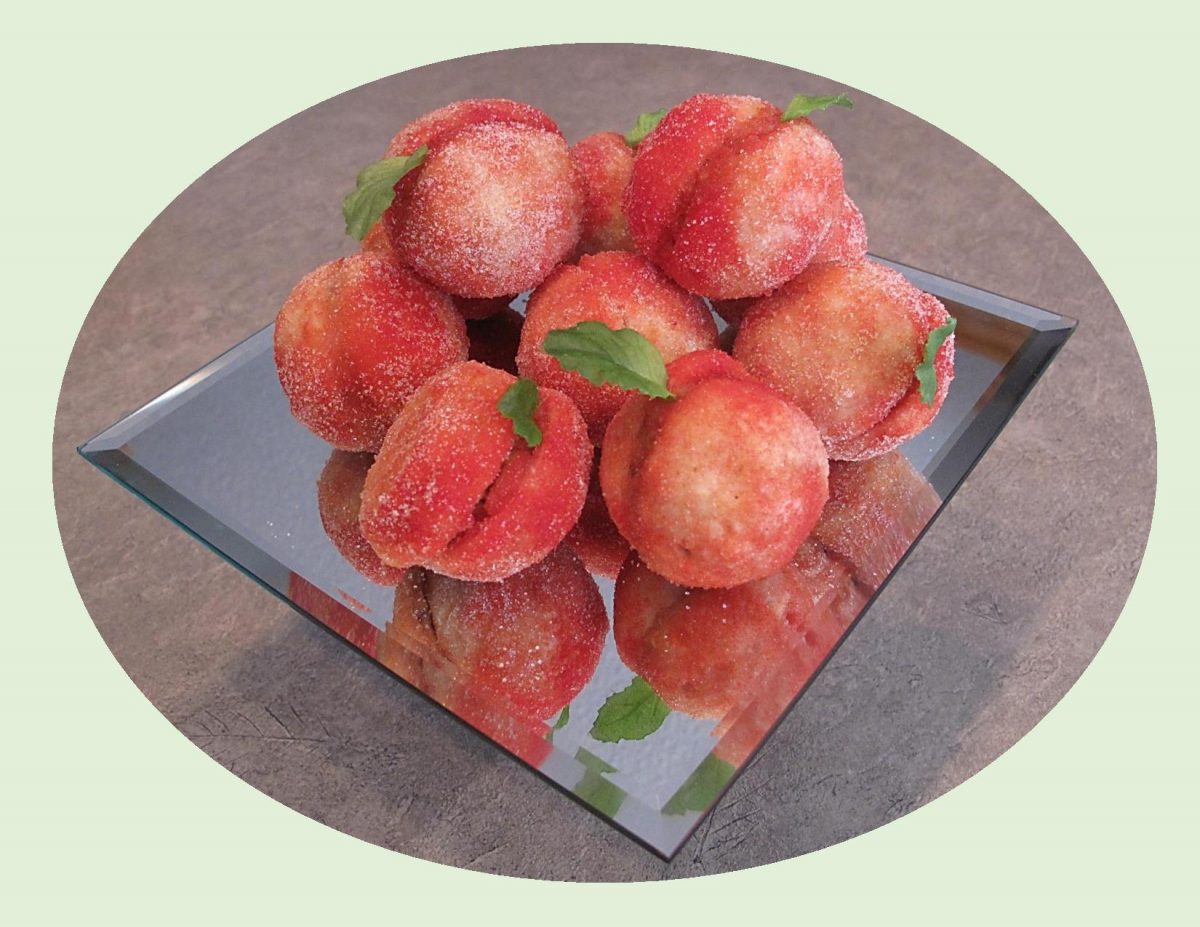
It’s that wonderful time of year when there is an abundance of fresh fruit available so why not make the most of it?! Peaches are a favorite of mine, not only because of their great taste but they have such versatility in their uses. Just for something different today, I want to take the peach idea in a whole different direction. These beautiful, old fashioned pastries were very popular in the 1980’s. They are known for their unique look that resembles a fresh peach with a flavor that is delicately sweet and buttery. Traditionally served at Italian wedding showers, Pesche (or peach), are now served at any celebration and may be found throughout many countries in Europe.
Peach cookies are two cookie domes, carved on the inside and paired together to hold a dollop of custard. Once assembled, they are dipped in Alchermes, a crimson colored liqueur infused with a blend of anise flowers, cinnamon, cloves, coriander, jasmine, mace, nutmeg, orange peel, sugar and vanilla. These ingredients are stepped in alcohol, which is then flavored with rose water. Alchermes gives these pastries a vibrant pink hue and a unique, light alcohol flavor that combines custard and cookie beautifully. To further enhance the peach resemblance, they are rolled in a sanding sugar.
Alchermes is a very ancient liqueur of Arabic origin. It’s main feature is an unmistakable scarlet color, which was originally acquired by adding ‘kermes’, a scale insect that eat oak trees. Modern alchermes liqueurs no longer use the kermes insect. Alchermes was created in the Frati’ Convent at Santa Maria Novella in Florence, Italy.
These peach cookies are an impressive dessert, perfect for special summer occasions. You can use any filling you choose such as a pastry cream, lemon curd, limoncello or just plain nutella spread. Since it is almost impossible to find the alchermes liqueur in Canada, I’ve listed a few substitutes that can be used instead.
Print Recipe
Peach Cookies or Pesche
Votes: 2
Rating: 4.5
You:
Rate this recipe!
|
|
Votes: 2
Rating: 4.5
You:
Rate this recipe!
|
Instructions
Cookie Dough
Preheat oven to 350 F. Line a cookie sheet with parchment paper.
In a large bowl, sift flour & baking powder. In another bowl, whisk egg with sugar until combined & fluffy. Whisk in milk, melted butter, vanilla & lemon zest until well combined. Gradually add flour mixture into wet ingredients until incorporated & a soft dough is achieved. Form the dough into 16-20 small balls; place on baking sheet & press slightly on top to flatten a bit.
Bake for approximately 15-20 minutes. Remove from oven & cool on wire rack until cool enough to hold. With a sharp small knife remove the middle of the cookie forming a small hole. Reserve crumbs for filling.
Filling
In a small bowl, combine filling ingredients; stir in reserved crumbs. Spoon into center holes of cookies & press together to form a peach.
Coating
In a shallow bowl, combine lemon & peach gelatin powder. Place package of strawberry gelatin in another bowl. Place sugar in a third bowl.
Assembling
Working with one cookie at a time, spritz cookie with a bit of water. Dip in lemon mixture, then in strawberry gelatin & then in sugar. Spritz with additional water & add more gelatin as needed to create desired 'peach blush' effect. Place on a wire rack to dry for an hour. Attach mint leaves to top of each cookie with additional preserves. Store in refrigerator.
-
Recipe Notes
- Alchermes can be substituted for a peach liqueur or Chambord raspberry liqueur. For my peach cookies, I kept it simple & used a combination of jello powders to replicate the traditional idea.
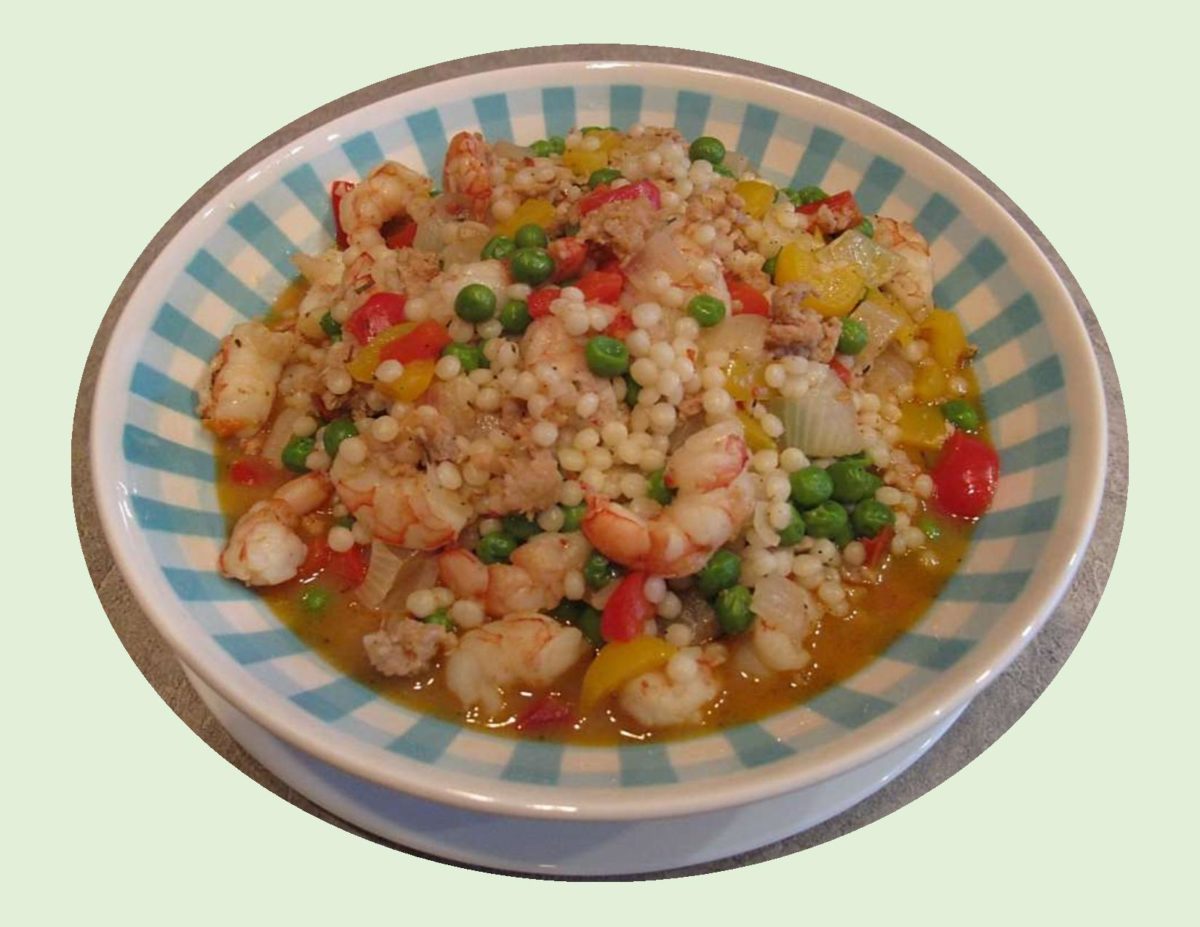
When it comes to the traditional flavor of paella, it all comes down to location. If you live by the sea, its common to use shellfish. For people living inland, other proteins are used that are readily available.
Confirmed as Spain’s best loved contribution to world cuisine, paella is typically prepared with rice, saffron, seafood, chicken and Spanish chorizo sausage.
In regards to the rice used, bomba rice absorbs the flavors of the oil, stock and other ingredients. Arborio will get a bit creamy, whereas jasmine and basmati add flavor instead of soaking others up. Long grain just doesn’t have the right texture for paella.
To put a little different spin on my paella today, I’m preparing it with Israeli couscous. Israeli or pearl couscous is a small, round pasta-like granule made from semolina and wheat flour. It should not be confused with the tiny, yellow North African couscous. Israeli couscous is twice as large and is toasted rather than dried, which gives it a nutty flavor and a hearty texture.It easily absorbs flavors, making it very versatile as a base for chicken and fish or in soups, salads, pilafs, etc.
I’ve made couscous with rice as well as the short vermicelli noodles. Today is the first time with couscous and we really enjoyed it.
Print Recipe
Couscous Shrimp Paella
Votes: 2
Rating: 4
You:
Rate this recipe!
Ingredients
- 1 Tbsp olive oil
- 1 medium onion
- 3 cloves garlic, chopped
- 1 medium sweet red pepper, cut into 1/2" dice
- 1 medium sweet yellow pepper, cut into 1/2" dice
- 1 tsp salt
- 1/2 tsp EACH pepper, dried thyme, red pepper flakes, turmeric
- 1 3/4 cups chicken broth
- 1 cup water
- 250 grams Asiago/red pepper pork sausage
- 1 cup frozen peas, thawed
- 300 grams WILD, fresh large shrimp, peeled & deveined
- 240 grams (1 1/2 cups) Israeli or Pearl couscous
- 1/2 cup black olives, pitted & sliced
Ingredients
- 1 Tbsp olive oil
- 1 medium onion
- 3 cloves garlic, chopped
- 1 medium sweet red pepper, cut into 1/2" dice
- 1 medium sweet yellow pepper, cut into 1/2" dice
- 1 tsp salt
- 1/2 tsp EACH pepper, dried thyme, red pepper flakes, turmeric
- 1 3/4 cups chicken broth
- 1 cup water
- 250 grams Asiago/red pepper pork sausage
- 1 cup frozen peas, thawed
- 300 grams WILD, fresh large shrimp, peeled & deveined
- 240 grams (1 1/2 cups) Israeli or Pearl couscous
- 1/2 cup black olives, pitted & sliced
|
Votes: 2
Rating: 4
You:
Rate this recipe!
|
Instructions
In a large heavy saucepan, heat oil. Add onion, garlic & sweet peppers; cook until tender-crisp, about 8 minutes. Add all of the spices; cook 1 minute more, remove to a dish & set aside.
In the saucepan, scramble-fry sausage meat. Add broth, water & couscous; simmer, covered 10 minutes. Stir in peas & shrimp; simmer another 5 minutes or only until shrimp is cooked. Add seasoned vegetables, gently stir to combine. Serve, garnished with olives.

No other spice more completely captures the essence of the exotic. Cardamom’s complex flavor is difficult to describe. There’s nothing subtle about cardamom, so when used in all but sparing amounts it will dominate whatever its paired with. Used properly, it elevates sweet and savory dishes, adding layers of flavor.
A versatile spice, in that it can be used in everything from desserts to main courses. Relatively expensive, coming in after saffron and pure vanilla, but well worth the expense.
Today, I’m back to ‘recipe development’. My plan is to create some tender, little orange cakes and topping them with a fruit and spice mixture reminiscent of flavors from Morocco.
Print Recipe
Cardamom Fruit Cakes with Rum Sauce
Votes: 1
Rating: 5
You:
Rate this recipe!
|
|
Votes: 1
Rating: 5
You:
Rate this recipe!
|
Instructions
Fruit Topping Mixture
-
In a small bowl, combine dates, apricots, raisins, apple & remaining orange juice & zest from cake ingredients. Season with cardamom & mace; mix well. Preheat oven to 350 F. Lightly butter 6 custard baking cups. Divide fruit between them; covering bottom & pressing a bit up the sides. Set aside.
Cake
-
In a small bowl, beat together eggs & sugar until thick; gradually beat in oil. In a small dish, combine flour, baking powder & salt. Stir flour into egg/sugar mixture, then add orange juice. Combine well then add zest & vanilla.
-
Pour the batter over fruit in custard cups, dividing it evenly between them. Bake 15-20 minutes or until they test done with a toothpick. Allow the cakes to cool for about 5 minutes, then invert onto a rack to finish cooling. When ready to serve, place on individual dessert plates & drizzle with warm rum sauce.
Rum Sauce
-
In a small saucepan, over medium heat, melt butter. Combine sugar & cornstarch; stir into melted butter. Slowly pour in milk, stirring frequently until mixture begins to lightly boil. Continue cooking until thick, stirring constantly. Remove from heat & stir in rum extract. Serve warm.

Scones were originally made from oats and shaped into a large round called a ‘bannock’. Each round was scored into four to six triangles and cooked on a griddle either over an open fire or on top of the stove.
A scone is not a cupcake. Making scones is like stirring together biscuits. A simple mixture of flour, salt, baking powder and/or soda, milk or sour cream, butter and sometimes eggs. Scones are the perfect blank canvas and can be flavored to taste and loaded with add-ons.
Many times, scones have been perceived as dry and boring. The classic scone is crusty on the outside and biscuit textured within. A cakey super moist texture should not be expected in a scone.
We found this dried fruit scone was excellent eaten slightly warm. The cardamom spice really enhanced the flavor of the papaya fruit in them. I used the flour/oatmeal combo, as I most often do because of the the nice texture and taste it gives. The glaze is optional as it kind of goes against the basics of a scone but what the heck!
Print Recipe
Tropical Papaya Scones with Vanilla Glaze
Votes: 6
Rating: 5
You:
Rate this recipe!
|
|
Votes: 6
Rating: 5
You:
Rate this recipe!
|
Instructions
Papaya Scones
Preheat oven to 350 F. Line a baking sheet with parchment paper.
In a food processor, pulse oatmeal for a few seconds then add next 5 ingredients & pulse a few more seconds. Add butter; whirl ONLY until mixture resembles coarse crumbs then place in a large bowl. Stir in chopped fruit.
In a small bowl, whisk together sour cream, milk & vanilla. Add to dry mixture blending only until JUST incorporated. Scoop onto baking sheet & bake for 10-12 minutes. Remove from oven & allow to cool slightly.
Vanilla Glaze
In a small bowl, whisk together glaze ingredients until smooth. With a small spoon, drizzle glaze over scones.
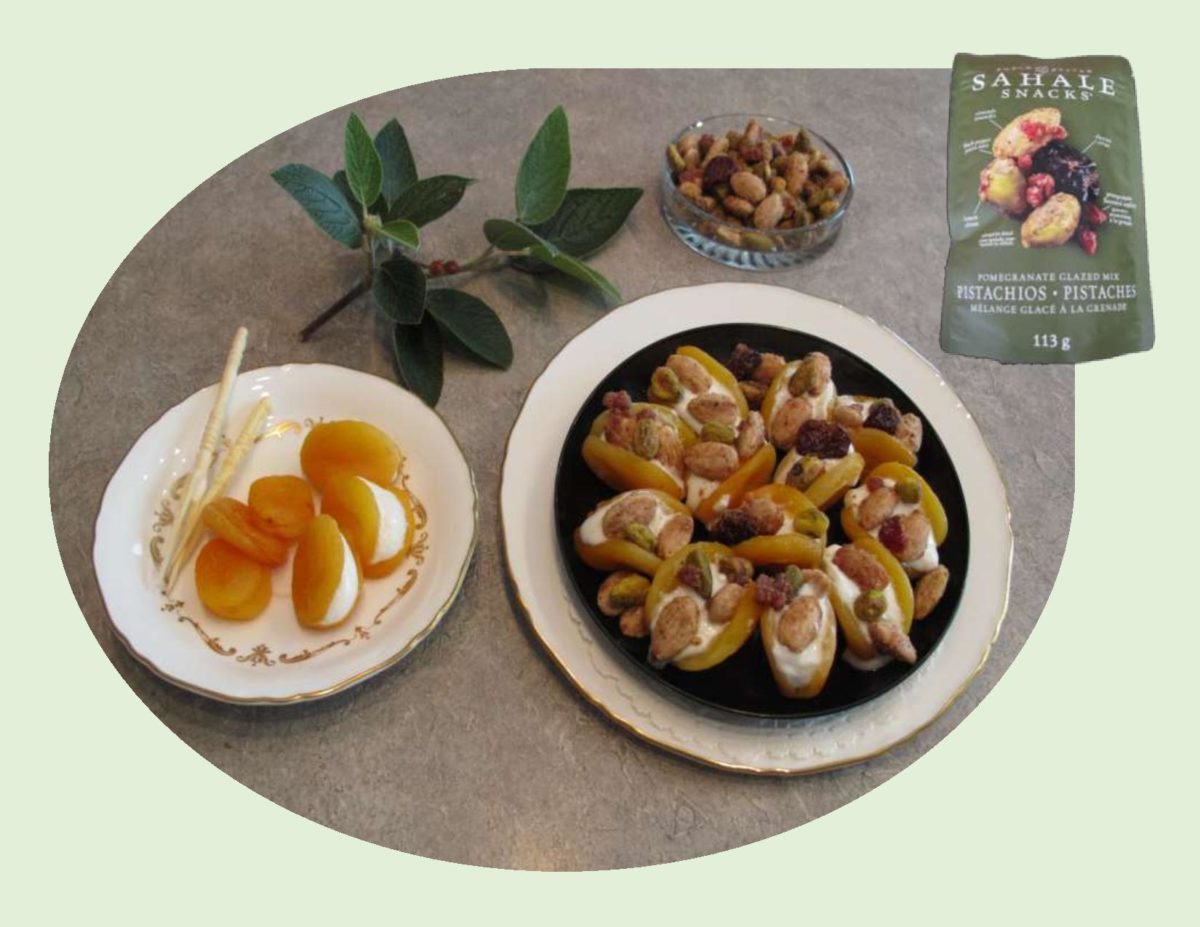
The majority of dried apricots available on the market come from Turkey. What sets them apart from others, is the way they are dried. Generally, Turkish apricots are dried whole, then pitted, resulting in a plumper, thicker fruit then apricots that are pitted before drying.
A velvety sweetness emerges from the golden orange disks, grown on the sun-drenched Mediterranean coast. Apricots are a relative of the peach with an ancient linage that reaches back to China.
These incredibly easy little hors d ouvers, evoke images of the vibrant colorful markets we saw when we visited the country of Morocco. The dried apricots are soaked, candied, stuffed with Greek yogurt and garnished with a unique glazed medley of pistachios, almonds, cherries, pomegranate-flavored apples, a touch of lemon and a dash of pepper. This all comes together to make a perfect, lightly sweet/spicy, one-bite treat with the help of a package of ‘Sahale Snacks’. Gourmet in minutes!
Print Recipe
Turkish-Style Stuffed Apricots
Votes: 1
Rating: 5
You:
Rate this recipe!
|
|
Votes: 1
Rating: 5
You:
Rate this recipe!
|
Instructions
Soak the apricots in water overnight. In a small saucepan, combine apricots with their soaking water & sugar; bring to a simmer & cook for about 10 minutes. The syrup should thicken slightly; remove from heat & allow to cool. Once cooled, drain off any excess syrup.
Slice apricots lengthwise 3/4 of the way through. Place about 1 tsp of yogurt in side of each one then press a glazed pistachio or almond into the yogurt. Repeat with the rest of the apricots & serve with the remaining glazed nut & fruit mixture on the side.

Anyone following my blog is well aware of my love for rhubarb. I think I’ve tried to use it in every capacity possible. Well, get ready for my next adventure — rhubarb Turkish delight! I refrain from eating a lot of chocolate bars, not that I don’t enjoy them, but seriously –. In Canada, the Nestle company sells a chocolate bar called ‘Big Turk’ for which Turkish delight forms the basic foundation. Of course, I love it!
Just a bit of food history background on the subject first. The Turkish name for the sweet comes from the Arabic rahat-ul hulkum which means ‘soothe or heal the throat’. This was abbreviated to rahat lokum and then lokum. The name ‘Turkish Delight’ was coined in the 18th century to make it easier to pronounce. As an improvement on the original recipe of honey or molasses, a mixture of water, flour, cornstarch and refined beet sugar were used to make a firm, chewy jelly.
Little has changed in the last 240 years. Although there are more than 24 different flavors, the biggest seller that still remains is a plain jelly studded with pistachios. Traditional Middle Eastern flavors include rose-pistachio, orange-blossom walnut, mint and rose-lemon.
Back to the rhubarb. Somewhere in my travels, I came across a recipe for rhubarb truffles that peeked my interest. After more research, I decided why not go right out on a limb and test my skills at making some rhubarb/rose Turkish delight. Actually, the end result was not bad. I have acquired a taste for the use of floral water in baking, Brion, not so much. It has to be used very sparingly or it becomes overpowering. I made three versions: Turkish delight plain or covered in white chocolate and a rhubarb truffle. A bit time consuming but a very unique flavor.
Print Recipe
Rhubarb/Rose Turkish Delights & Chocolates
Votes: 1
Rating: 5
You:
Rate this recipe!
Ingredients
Rhubarb/Rose Turkish Delight
Rhubarb Cream Cheese Truffles
Ingredients
Rhubarb/Rose Turkish Delight
Rhubarb Cream Cheese Truffles
|
Votes: 1
Rating: 5
You:
Rate this recipe!
|
Instructions
Rhubarb/Rose Turkish Delight
In a saucepan, put 1 1/4 cups water with sugar, rhubarb & lemon juice. Cook over low heat , stirring until sugar has dissolved, then increase the heat a little; simmer 5 minutes. Remove from heat; leave the rhubarb to infuse for 10 minutes, then pass through a sieve, reserving the juice & pulp separately (the pulp can be used in the truffles that follow).
Line a baking dish with cling film (the size will depend on how thick you want your candy) & set aside. In a small dish, blend cornstarch with remaining 1/4 cup water until smooth. In a saucepan, add rhubarb juice, gelatin powder, dissolved cornstarch & heat gently, stirring until gelatin has dissolved, then bring to a rolling boil.
Keep mixture at a steady rolling boil, stirring constantly, for about 12-14 minutes or until syrup reaches a soft ball stage. Cool slightly & then pour mixture into lined baking dish. Allow to cool at room temperature for about 12 hours or until the mixture is set; do not refrigerate.
Once the jelly is set, cut into pieces. Combine 1 Tbsp cornstarch with 2 Tbsp powdered sugar in a bowl, then roll the jellies in this mixture to coat them. Keep jellies in an airtight container in a cool place for up to 3 days; do not refrigerate. If you want to dip some of your jellies as I did, I found using a mini ice cube tray as a mold was helpful. I just set the piece of jelly in each cup & poured the white chocolate over & around it. Can be frozen until needed.
Rhubarb Cream Cheese Truffles
In a double boiler over medium heat, melt 55 grams of white chocolate chunks. Transfer to a bowl; add remaining ingredients EXCEPT milk chocolate & beat with an electric hand mixer until smooth. Cover & chill until solid enough to roll or scoop into balls.
Line a baking sheet with parchment paper. Melt milk chocolate. drop balls of rhubarb/cream cheese mixture, one at a time, into milk chocolate to coat. Carefully remove onto parchment paper & allow to harden. Can be frozen as well until needed.
-
Recipe Notes
- I also tried freezing the plain jellies without putting cornstarch/sugar mixture on them and it worked fine. They were actually nice tasting right out of the freezer.

We are definitely well on our way to the ‘holiday’ season. For some, there will be endless social events and family gatherings, all of which require those quintessential little bite-size hors’d’ouvers. Being someone who loves to work with food, the Christmas season is like a blank canvas. Having spent a lifetime in the commercial food industry, I’m definitely no stranger to the endless hours of preparing these tasty little morsels. It gives you the ultimate presentation challenge when hundreds are required (as well as being tiring and a bit tedious at times).
One item that seems to always add a special note of elegance is the use of figs. Not for everyone, but for those who do enjoy them, they are irresistible. Figs can be eaten raw, grilled, poached or baked and can be paired with walnuts, honey, cheese, wine, citrus, cured meats and a variety of spices.
Turkey is the largest producer of figs in the world. The Smyrna/Calimyrna figs arrived in California, USA. in the 18th century, along with a special breed of wasp once needed for fertilization. Today, the most widely grown types of figs, including Black Mission, self-pollinate without any wasp labor.
The base of the fig plant’s flower, or soft pod, and little ‘seeds’ are the fruit’s structure and are all edible. Dried figs keep well without refrigeration and give you that concentrated, sweet flavor.
These ‘fast and fabulous’, three ingredient hors’d’ouvers are truly a must for all fig lovers!
Print Recipe
Turkish Figs with Anise & Walnuts
Votes: 2
Rating: 5
You:
Rate this recipe!
|
|
Votes: 2
Rating: 5
You:
Rate this recipe!
|
Instructions
-
Cut hard stem from the top of figs & discard. Slice figs in half horizontally & place sliced side up on a baking sheet. Using your finger, make a depression in the center of each. Place a 1/4 tsp of honey on each half & sprinkle with ground anise or seeds.
Press a walnut halve into center of each fig the top with grated cheese. Bake until cheese melts & is bubbly, about 5 minutes. Serve.
